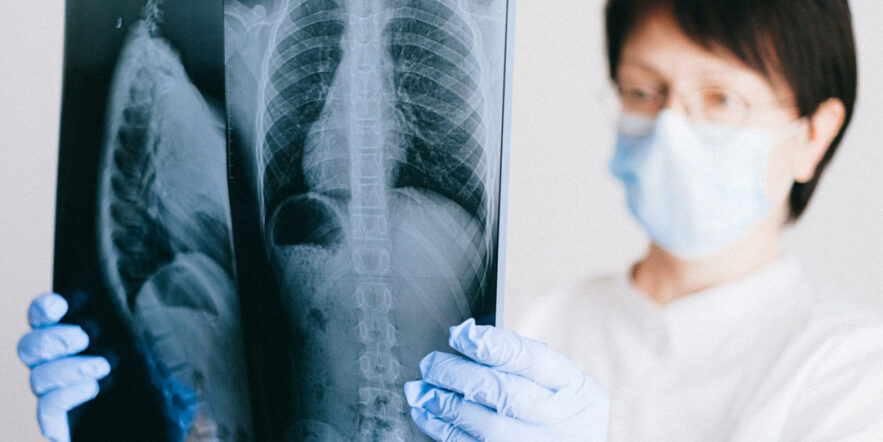COPD is a chronic, progressive lung disease that interferes with your ability to breathe because it limits lung airflow. COPD stands for chronic obstructive pulmonary disease.
Most commonly, people with COPD have emphysema, in which the walls between the air sacs in the lungs (alveoli) lose their shape and elasticity, hyperinflating and trapping air inside; and chronic bronchitis, in which the lining of the airways is chronically irritated and the walls of the airways can become thick and inflamed. Mucus production increases, clogging the airways and making breathing even harder.
There is no cure for COPD and no way to reverse the damage to the lungs, but there are medicines, therapies and lifestyle changes that can treat it and slow the progress of the disease.
Browse This Article
Prevalence and Causes of COPD
According to the Centers for Disease Control and Prevention (CDC), 16 million Americans have been diagnosed with COPD and millions more have it but have not been diagnosed. In 2018, COPD was the third leading cause of death caused by disease among Americans.
Most cases of COPD — about 80% — are directly related to cigarette smoking. Other types of lung irritants, such as dust and long-term exposure to secondhand smoke, air pollution or chemical fumes can also contribute to COPD. Less commonly, it can be caused by a congenital condition called alpha-1 antitrypsin deficiency, in which the body produces a defective version of a protein that normally protects the lungs in the presence of inflammation, infection, or smoking.
Vaccinations against the flu, pneumococcal pneumonia and, if necessary, pertussis are recommended. COPD increases the risk of these diseases, and people with COPD are more likely to have complications if they do get them.
Not surprisingly, people with COPD who get COVID-19 are at much greater risk of severe illness and death than COVID-19 patients who don’t have COPD. In a 2020 study published in the journal PLOS ONE, researchers analyzed data on patients who had both COPD and COVID-19. Out of 2,473 COVID-19 patients, 2.3% also had COPD. Critically ill COVID-19 patients with COPD had a 63% risk of severe disease and a 60% risk of death, while those COVID-19 patients who did not have COPD had only a 33.4% risk of severe disease and a 55% risk of death. For people with COPD, it’s especially important to take measures to avoid getting sick, including staying home as much as possible and washing hands often.
Treating COPD
In choosing diagnostic and management plans for COPD patients, physicians often refer to a report called the Global Strategy for the Diagnosis, Management and Prevention of COPD. The report is produced by the Global Initiative for Chronic Obstructive Lung Disease (GOLD), an organization created in 2001 to improve diagnostic and treatment outcomes in COPD. Based on an analysis of published studies, a new report is developed every year as a reference tool to improve the way physicians handle COPD.
GOLD, the National Heart, Lung, and Blood Institute and other lung disease organizations agree that goals for treatment of COPD should include:
- Relieving symptoms
- Improving a person’s ability to exercise
- Slowing progression of the disease
- Preventing and treating exacerbations (sudden worsening of symptoms also called flare-ups)
Bronchodilators and inhaled corticosteroids are mainstays of treatment for COPD.
Bronchodilators
Bronchodilators are drugs that relax the muscles around the airways, allowing more air to flow into and out of the lungs, making it easier to breathe. Several classes of drugs are used as bronchodilators. Typically, bronchodilators are administered using a device called an inhaler, which forces the drug through the mouth directly to the lungs. Less commonly, a nebulizer is used. A nebulizer is a small machine that changes liquid medicine into a fine mist that is inhaled through a mouthpiece or mask. Following are some of the bronchodilators used in COPD.
Beta-agonists are bronchodilators that work by relaxing the muscles around the small airways (the bronchioles). Short-acting beta-agonists may be used regularly or as needed. Sometimes referred to as rescue drugs, their effects last four to six hours. Short-acting beta-agonists include ProAir and Proventil (albuterol), Xopenex (levalbuterol) and Brethine (terbutaline)
Long-acting beta-agonists, with effects lasting 12 hours or more, are taken on a regular basis to prevent or reduce symptoms. Long-acting beta-agonists include Striverdi Respimat (olodaterol), Arcapta (indacaterol) and Serevent (salmeterol)
Side effects of beta-agonists include a fast heartbeat, heart palpitations, nervousness, anxiety, uncontrollable shaking of a body part and cramping of the hands, legs and feet. Sometimes side effects go away within minutes of using an inhaler, and sometimes they diminish over time, with continued use of the drug. Side effects may be reduced by using correct inhaler technique, rinsing your mouth after inhaling, and using your inhaler(s) only as frequently as prescribed. More seriously, long-acting beta-agonists have been associated with an increase in cardiovascular events (such as heart failure, ischemic stroke, cardiac arrhythmia or myocardial infarction) in people over age 65.
Anticholinergic drugs
Known as antimuscarinic drugs, these are a type of bronchodilator that work by preventing the large airways (the bronchi) from tightening. They also reduce the production of mucus in the airways.
Short-acting anticholinergics such as Atrovent (ipratropium) relieve symptoms for four to six hours. Long-acting anticholinergics, such as Tudorza (aclidinium), Spiriva (tiotropium), Yupelri (revefenacin) and Incruse (umeclidinium) work for 12 hours or longer and are taken every day.
A common side effect of anticholinergics is dry mouth which, in addition to being uncomfortable, can lead to tooth decay, gum disease, sores in the mouth, fungal infections in the mouth, cracked lips and poor nutrition due to difficulty chewing and swallowing. Dry mouth can be treated by using prescription or over-the-counter mouth moisturizers; taking frequent, small sips of water; chewing sugar-free gum or sucking sugar-free candies; and avoiding any products that contribute to dry mouth such as alcohol, tobacco and over-the-counter antihistamines and decongestants.
Anticholinergic drugs can cause dry eye, urinary retention, constipation, stomach pain and vision problems. Long-acting anticholinergics have been associated with an increase in cardiovascular events in people over age 65. Anticholinergics have also been associated with acute urinary retention, which can be a life threatening emergency, in older men with benign prostatic hyperplasia.
A 2020 study in the journal Drugs & Aging revealed that anticholinergic medications were associated with an increased risk of hospitalization due to falls and fractures. The researchers analyzed data pertaining to hospitalizations and medication use in about 25,000 people, average age 58, over a 19-year period. The researchers suggested that cognitive impairment, weakness, visual problems and other side effects of anticholinergic drugs contribute to the increased risk of bad falls in older people. And earlier research using the same database found a potential increased risk of cardiovascular disease and death in middle and older age people.
Researchers in both of these studies note that further studies are required to confirm these conclusions and determine whether reducing anticholinergic use when possible may reduce these risks. In the meantime, the 2020 GOLD report points out that in a large, long-term clinical trial in COPD patients, tiotropium added to other standard therapies had no effect on cardiovascular risk.
Methylxanthines
Methylxanthines are another type of bronchodilator that relax the muscles surrounding the airways and may also decrease swelling in the lungs. However, theophylline (brand names Theolair and Uniphyl), the most commonly used methylxanthine, is less effective than other long-acting bronchodilators and has more side effects, so it is not recommended if other alternatives are available.
Side effects include the development of atrial and ventricular arrhythmias (heart rhythm irregularities, which can be fatal) and seizures (which can occur in people with no history of epilepsy). Other side effects include headaches, insomnia, nausea and heartburn. Methylxanthines have significant interactions with a number of commonly used drugs, complicating their use.
Bottom line, the 2020 GOLD report states that methylxanthines are not recommended for COPD exacerbations, as there are safer, more effective bronchodilating therapies.
Corticosteroids
Corticosteroids, also called glucocorticoids or steroids, reduce inflammation in the airways and are usually used in combination with bronchodilators. They are administered using either an inhaler or a nebulizer. Inhaled corticosteroids (ICS) decrease swelling in the airways. Regular treatment with them improves symptoms, lung function and quality of life, and reduces the frequency of COPD exacerbations. Inhaled corticosteroids include Pulmicort (budesonide) and Flovent (fluticasone). Both are approved for asthma but are used off-label for COPD.
The use of ICS in COPD has been controversial because studies show that some can increase the risk of pneumonia. Data from a trial called UPLIFT (Understanding Potential Long-term Impacts on Function with Tiotropium) indicated that people taking the ICS fluticasone propionate have a roughly 33% greater risk of pneumonia compared with those not taking an ICS. They also have a 28% greater risk compared with people taking a different ICS. Inhaled budesonide has also been linked to an increase in pneumonia risk.
In addition to the potential increased pneumonia risk, ICS use is associated with oral candidiasis (a yeast infection of the mouth or throat, often called thrush), a hoarse voice and sore throat. Some of these side effects can be minimized and even prevented by rinsing your mouth after using your inhaler. The American Lung Association recommends that after using your inhaler take a full sip of water, swish it around in your mouth for about 30 seconds and spit it out. Do not swallow the water. This helps prevent hoarseness, throat irritation, and infections in the mouth.
Using a spacer device with your inhaler can also help prevent these symptoms. The spacer connects to the mouthpiece of the inhaler. The medicine goes into the spacer first and then is inhaled into the lungs. As the medicine travels through the spacer the size and speed of the particles of medicine is reduced. As a result less medicine is deposited into the mouth and throat.
Phosphodiesterase-4 inhibitors
Phosphodiesterase-4 (PDE4) inhibitors reduce inflammation and are generally used in combination with long-acting bronchodilators. The PDE4 inhibitor Daliresp (roflumilast) is taken as a tablet and does not have bronchodilating effects. It is used in a subgroup of COPD patients whose symptoms persist or get worse in spite of treatment with bronchodilator/corticosteroid combinations, and experience recurrent exacerbations and hospitalization.
PDE4 inhibitors are used with caution because they have more adverse effects than other medications for COPD, including nausea, reduced appetite, abdominal pain, diarrhea, sleep disturbances, and headache. Rarely, serious side effects may occur, including depression, thoughts of suicide, severe anxiety, emotional instability, or confusion.
Combination drugs
Combination drugs, in which two or more drugs are combined in one inhaler or nebulizer solution, may offer some benefits over drugs taken separately. Studies have shown that combining drugs from different classes may improve symptoms without causing more — or more severe — side effects, compared to increasing the dose of a single drug. Also, people may find it easier to manage their medications when only one inhaler is needed to take two or more drugs — rather than multiple inhalers. When treatment is easier and it reduces symptoms better, people may be more likely to follow their treatment plan as prescribed.
Some combinations commonly used in COPD include:
- Long-acting beta-agonists plus corticosteroid such as Symbicort (formoterol/budesonide), Advair (salmeterol/fluticasone)
- Long-acting anticholinergic plus a long-acting beta-agonist such as Anoro Ellipta (umeclidinium/vilanterol), Stiolto Respimat (tiotropium/olodaterol)
- A corticosteroid and a long-acting beta-agonist such as Breo Ellipta (fluticasone/vilanterol)
- A corticosteroid, long-acting anticholinergic plus a long-acting beta-agonist such as
Trelegy Ellipta (fluticasone/umeclidinium/vilanterol), Breztri Aerosphere (budesonide/glycopyrrolate/formoterol fumarate)
Antibiotics
Antibiotics may be used to treat exacerbations when there is more shortness of breath, coughing and more mucus. Often these symptoms will occur when a bacterial infection is present. Antibiotics may also be used continuously or intermittently to prevent flare-ups.
Ultimately, the choice of drug therapy should be individualized and should take into consideration the severity of a person’s symptoms and the frequency of exacerbations, or flare-ups, of the disease.
“In general,” says Philip Diaz, MD, director of pulmonary rehabilitation services and medical director of respiratory therapy at The Ohio State University Wexner Medical Center, in Columbus, “COPD drugs are fairly well-tolerated.”
More Drug Options On the Horizon
Ensifentrine, formerly called RPL554, has been developed by Verona Pharma in London and is both a PDE3 and PDE4 inhibitor. Currently in clinical trials, early research shows some benefits for breathlessness.“It’s interesting as it may offer a unique combination of bronchodilating properties and anti-inflammatory effects in a nebulized form,” says Dr. Diaz. That means it can address COPD on two fronts: bronchoconstriction and inflammation.
A PDE4 called CHF6001 is under development for COPD by Chiesi Farmaceutici in Italy. The drug shows promise for reducing airway inflammation in COPD.
While these two may not be all that different from current drugs, says Dr. Diaz, they will at least provide more options for patients.
Other Treatment Options
- Oxygen therapy can be helpful for people with severe COPD and low blood oxygen levels. Oxygen therapy increases the amount of oxygen in your lungs and bloodstream, which can help you breathe more easily. Oxygen treatment can be delivered through oxygen concentrators, cylinders or liquid-oxygen devices. These systems are portable and can be used during activity as well as during rest. Oxygen therapy is often used long-term and can improve quality of life and reduce the risk of death.
- Surgery may be an option for emphysema in people with COPD who are strong enough to withstand it and able to participate in a pulmonary rehabilitation program afterwards. And if they smoke, they need to quit. The major types of surgery for COPD are bullectomy, lung volume reduction (LVRS) and lung transplantation.
- A bullectomy removes large air sacs called bullae, which are formed from hundreds of destroyed alveoli (tiny air sacs that allow oxygen to get into the blood). Bullae can become large enough to crowd out healthier lung tissue and interfere with breathing. Bullectomy is used when bullae are large enough to occupy more than one-third of the right or left lungs.
- Lung volume reduction is a procedure to remove hyperinflated, damaged areas of the lungs, particularly in the upper portions, allowing the remaining lung to expand and function more normally. Typically 20% to 30% of the most damaged areas of the lungs are removed. By reducing the size of the lungs, the diaphragm, rib cage and chest wall are able to resume a normal shape and work more efficiently. Lung volume reduction is reserved for those whose symptoms still persist after all medical treatments and pulmonary rehabilitation have been tried. Potential surgery patients must have a strong enough heart and enough remaining healthy lung tissue to make the risks of surgery worthwhile.
- Bronchoscopic lung volume reduction is considered a less invasive potential alternative to lung volume reduction surgery. In this procedure, a bronchoscope is used to place three to five tiny valves in the airways to collapse the destroyed portions of the lung. The results are similar to those achieved by lung volume reduction surgery but without an invasive procedure. In 2018 the Food and Drug Administration (FDA) approved Zephyr endobronchial valves as the first bronchoscopic treatment for emphysema.
- Lung transplantation replaces damaged lungs with lungs from an organ donor, and is only considered if all other options have failed. Potential candidates for lung transplantation have severe lung disease but no other major health problems. But most COPD patients are not good candidates because there are risks for serious complications including rejection of the new lungs.
- Future minimally invasive options for severe emphysema may include lung volume reduction coil treatment. In this experimental procedure, small coils made of nickel and titanium are placed through a bronchoscope ino the damaged lung. The coils are thought to compress diseased lung tissue, allowing lungs to regain some function. In 2018 the FDA rejected premarket approval of the Elevair coil system, which has been under study since 2008, questioning whether the benefits of the device outweighed the risks. However, research continues on its use in select patients, and it is available in some countries outside the U.S.
- Other experimental treatments that may become available in the future include targeted lung denervation, which uses radiotherapy to induce permanent bronchodilation, and bronchoscopic thermal vapor ablation, which delivers heated water vapor to damaged tissue.
Pulmonary Rehabilitation
When used in combination with drug therapy, pulmonary rehabilitation can also significantly improve quality of life for people with COPD. Rehabilitation programs may include:
- Exercises to increase endurance
- Strategies for preserving energy by simplifying physical activities
- Breathing techniques
- General education about COPD
- Nutrition counseling
- Psychological support
Orlan Holmes, 69, who had COPD for 10 years before having a double lung transplant, had pulmonary rehab, and he speaks highly of the treatment’s benefits. “I invested in a pulse oximeter [a device that measures the oxygen level, or oxygen saturation, in the blood], so I could track when I was having problems. I could monitor my heart rate as well as my oxygen level. If my heart rate became too fast or my O2 level dropped below 89, then I needed to rest and do pursed lip breathing. I learned to do things more efficiently by monitoring my results.”
In pursed lip breathing, you inhale slowly through the nose, pursing your lips as if you were going to whistle, and breathe out slowly through your mouth while counting to four. This technique helps to slow your breathing and relieve shortness of breath.
A number of so-called airway clearance devices can also be helpful to some COPD patients. These aid in removing mucus from the airways and improving lung function. Some require a person to both inhale and exhale through the device, while others require only exhaling, or blowing into, the device.
The use of such devices is strictly patient-specific, says respiratory therapist Andrea Yagodich, who oversees the COPD education program at The Ohio State University Wexner Medical Center.
“If a COPD patient has an underlying case of pneumonia, then [an airway clearance device] may be beneficial,” Yagodich says. “The airway clearance devices we use are easy to use and generally well-received by the patients.”







